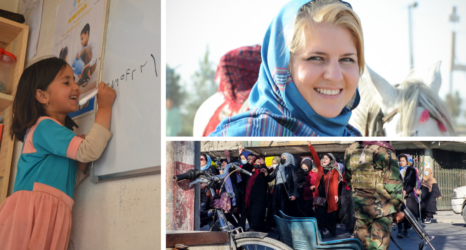It has been reported by numerous news outlets that the final push to win President Trump’s reversal of position on Afghanistan was a black and white 1972 picture of Afghan women in miniskirts. The picture of carefree and seemingly “westernized” women was used as evidence that Afghanistan is not a lost cause and that it is possible for it to revert back to those days. It worked. The President has unfurled of a new strategy for engagement in Afghanistan.
The irony is not lost on those engaged in advocacy to end gender-based violence: It was not long ago that images of Afghan women, clad in burqas, were put forth as reasons we must go to Afghanistan—to not only smoke out the terrorists hidden in the caves and mountains, but to liberate women from the Taliban’s brutal system of gender apartheid.
And yet, Trump stated in his speech announcing his Afghanistan strategy that “we are a partner and a friend, but we will not dictate to the Afghan people how to live, or how to govern their own complex society.” He added: “We are not nation-building again. We are killing terrorists.”
But what does that mean?
Does it mean our troops will drive out terrorists, such as the Taliban, but ignore the terror and violence that is daily experienced by the women and children of Afghanistan and imposed by misogynistic warlords with patriarchal views who are all too prominent in the parliament and local councils? Will this policy ignore the glaring connection, hidden in plain sight, between security of women and security of states?
Research conducted by Valerie Hudson reveals that “the overall level of violence against women is a better predictor of state peacefulness, compliance with international treaty obligations and relations with neighboring countries than indicators measuring the level of democracy, level of wealth and civilizational identity of the state.” If the Trump administration wants to root out terror it must look at the violence embedded in the very fabric of lives of Afghan women. If it plans to eliminate terrorism in Afghanistan, it must center gender.
At the forefront of strategies designed to root out and end violent extremism and terror must be an understanding of the conditions under which instability and insecurity thrive and terror rules. Trump appears to have missed that.
Despite the rights of women guaranteed in the country’s constitution, research by Global Rights estimates that almost nine out of 10 Afghan women face physical, sexual or psychological violence or are forced into marriage. On a weekly basis, there are reports of women being stoned to death, burned alive with gasoline and arrested and jailed because they ran away from an abusive husband. Girl are sold into marriage.
The violence perpetrated against women and girls in Afghanistan are not acts of collective violence—where a car is driven into a market place and rams down unsuspecting pedestrians, or where a suicide bomber attacks a school or a hospital to instill fear and —but instead, daily and individualized acts of terror perpetrated by “loved ones” at home. And what is practiced in the home and learned in the home seeps into society and becomes the norm. The norm that conflict is resolved through violence, that man is allowed to overpower woman and that this violence goes on with impunity is passed down from generation to generation—and normalizes insecurity and terror.
“We are here to kill terrorists” is not a strategy. Instead, it is tantamount to cutting off the head of hydra—where one is cut, two more grow.
To properly fight the war on terror, the Trump administration must invest in more than killing off perpetrators. It must expand its understanding of the root causes and drivers of violent extremism. In fact, it would do well to study the links between violent extremism and gender-based violence. Sexual violence, enslavement and removal of women and girls from the public sphere—these are all key strategies and have become part of the radical theology of violent extremist groups like the Taliban. These groups are not merely putting into practice long held “traditions” or “cultural” practices. They engage in selective reading of the Quran and hadith not to justify their actions but to deem praiseworthy the sexual assault of women and girls. The enslavement of women and girls serves to not only reward their combatants and attract recruits, but destroy families and destabilize communities. The trafficking and sale of women and girls funds their war chests and provides a steady source of income; in areas like Nigeria, where the high “bride price” makes future prospects of manhood a diminishing dream, the promise of a bride without the financial obligations is a key recruiting tool.
It has been said that a picture is worth a thousand words—but our policies cannot be driven by a superficial understanding of black and white photographs of women in miniskirts or women covered in burqas. The context is what matters: How is it that in a short span of time women who were seemingly free to wear what they wanted, get an education, work and vote were pushed out of the public space and behind walls of terror in their own homes?
This post is part of a series of responses to President Trump’s recent speech on U.S. strategies in Afghanistan. Read the rest here.





